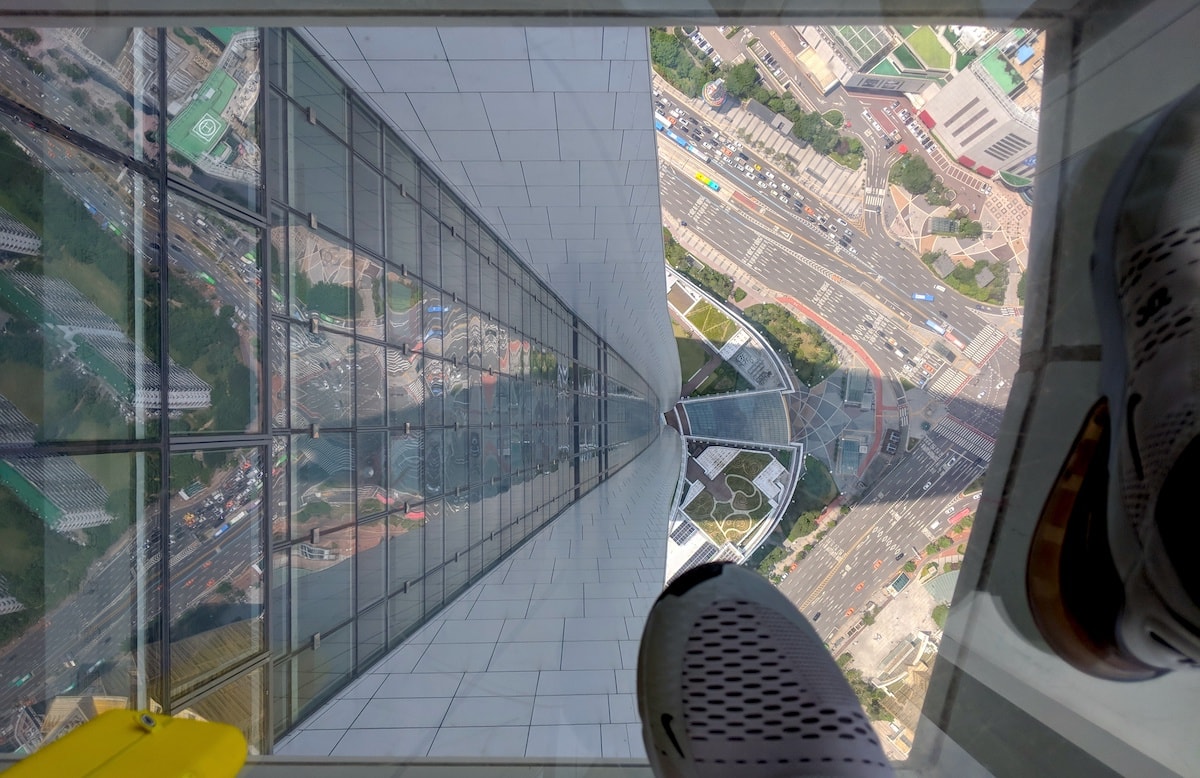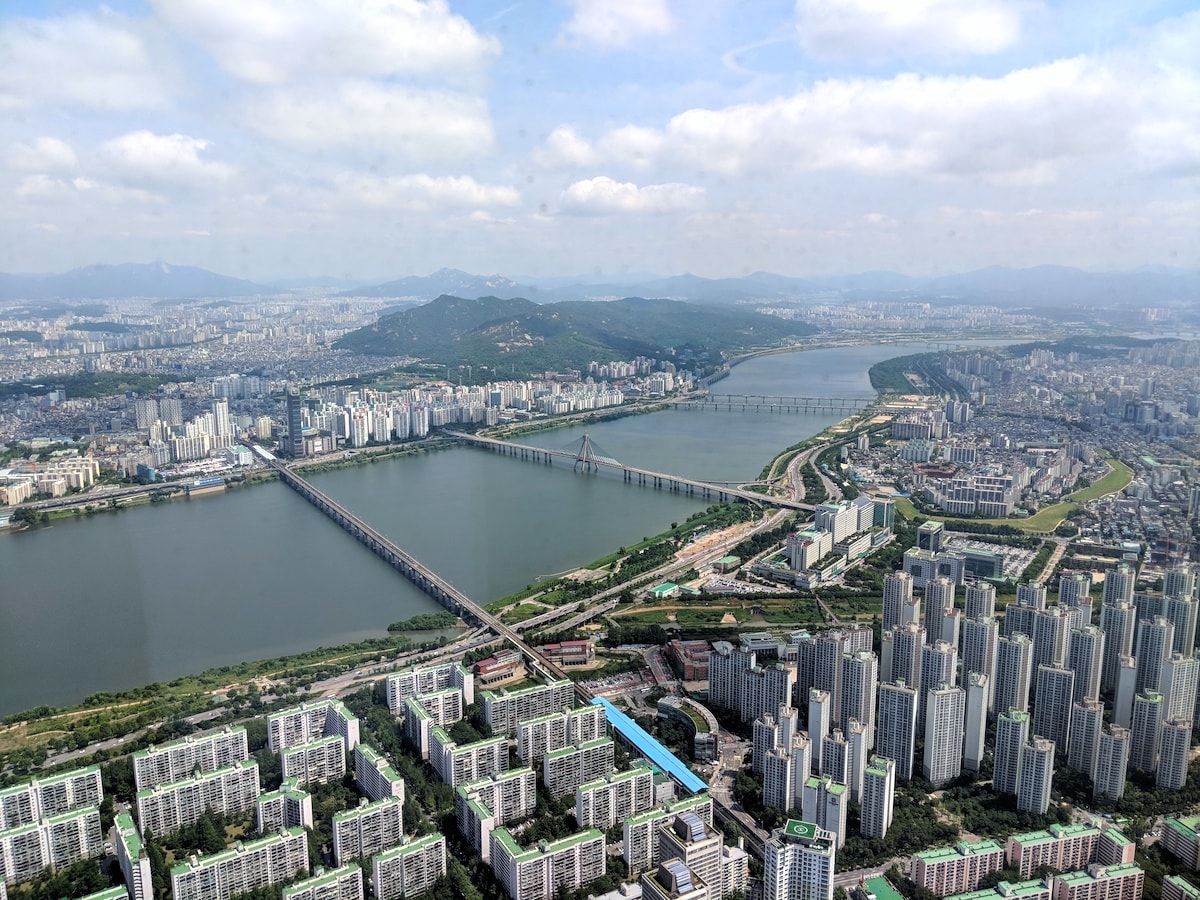One hundred and twenty floors above the Earth, the ground is surprisingly stable. Almost – but not quite – enough for me to feel safe jumping up and down on the glass floors of the observation deck suspended almost 1,800ft (550m) aboveground.

Once I adjust (as much as I can) to the sheer distance between me and my normal altitude of exactly zero feet above the ground, I look up.

This view is from Seoul Sky, the observation deck atop Lotte World 2, currently the tallest building in Korea and the fifth tallest in the world. At this altitude, every detail and vibration matters. My favorite tidbit from my own visit, from which I took this picture, is that the air pressure differential between the top and bottom floors is great enough that special air ventilation systems needed to be designed into the building, to prevent structural integrity issues inside the skyscraper. This building rises so tall into the sky, it quite literally has its own weather system.
From so far up in the air, your perspective changes. When you look out, non-obvious things become obvious. The way highrise apartments cluster around different parts of the city, the ways small mountains and hills interrupt the landscape, and how highways and interchanges snake around them. You see urban development and gentrification. You see the forest and the trees, in one view. Surrounded on all sides by this new, higher level of perspective, you see the city differently.
A few days ago, I attended a talk by Kindred Ventures’ Kanyi Maqubela, where I heard the same phrase in a new light.
Kanyi introduced me to the idea that there are different levels of common knowledge. There’s what everyone knows, by virtue of being human. This the ground-level stuff. And then there’s what we know, from being interested in a particular field. If you’re in the venture capital industry, there are certain things you know – “common knowledge” – as a matter of fact of being an investor. This is the level at which most of us operate in our respective fields of study. If you’re a musician, you know how to read sheet music. If you’re a software engineer, you know how to write the Fibonacci sequence. This kind of knowledge is table stakes for your day-to-day work. This is your average highrise in our metaphor. But there’s also a third layer – the common knowledge of the winners. These are the super-skyscrapers, the cloud-piercing, unicorn-chasing, stratospheric perspectives invisible to most other people, but obvious to those who’ve climbed to the top and achieved outlier levels of success.
Kanyi referred to this extra level of experience and insight as “higher levels of common knowledge.” These are observations and ideas that are obvious in hindsight after climbing to the top of an industry or craft, but almost impossible to intuit at any level below. In venture and entrepreneurship, these 120-story towers are the unicorns, the startups with exceptional scale and growth that appear a few times in every generation of companies. If you’re one of the first to join the team at Slack or an early executive at Dropbox or the first designer at Instagram, just by virtue of access – by just being there from the start – you have firsthand view of perspectives impossible to glean anywhere else. From such places, non-obvious things become obvious.
This higher level of perspective is one of the big reasons (alongside other factors like network) why many successful entrepreneurs have previous experience as early members of fast-growing teams: There is a certain class of knowledge that helps you get to the top faster and avoid the mistakes, but this knowledge is experiential. It’s about how to do things and when to do things, not what to do, and the best way to learn them right is by being there, seeing those messy mistakes and million-dollar bets unfold in vivo.
I’ve been asking myself whether it’s possible to spread this kind of higher-level knowledge to everyone else. How do we take what the masters have learned, and make it accessible to the rest of us? We can try to hear them out, and they can write books and treatises about what they saw, but I think much of that is imperfect. In venture, there’s no shortage of books and blog posts about how to do things right when you start a fast-growing company. But when I talk to founders about how to better prepare for growth, the line I hear over and over again is the same.
You can’t prepare to be a founder beyond a certain point, you can only prepare to learn as fast as possible on the job.
I have the feeling that master actors and directors in Hollywood or our generation’s best musicians and artists would say the same about their craft and industry. There’s a certain level of common knowledge that can be learned – that many people do learn – but the stuff that really matters at the tippy-top of success? The taste of a master chef or the finely tuned sense of rhythm of a writer? You can only internalize that kind of insight as you climb to the top, and your best bet is to learn as quickly as possible in the ascent.
Even if there isn’t a way to get the masters’ perspectives from the ground floor, I think there are ways to get a sense of what they see. If you’re early in your career or craft, ask those who have climbed above and ahead what they see now, what they’ve learned recently, that they didn’t see before. What’s new from their higher levels of perspective?
Most importantly, keep climbing the tower. Surround yourself with people who’ve been higher. And keep asking questions of perspective, not just knowledge – how can we look at the same parts of the world differently? What can you see at the top that’s invisible from below? What can you learn from the 1,800-foot view to guide your next steps?
I share new posts on my newsletter. If you liked this one, you should consider joining the list.
Have a comment or response? You can email me.